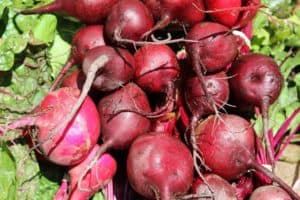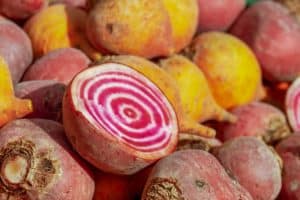Beets are a seriously underrated vegetable in the garden. A lot of people, including gardeners, tend to think of beets (some places like the UK call it beetroot) as a boring vegetable meant to play second fiddle to the stars of the garden–the tomatoes, the cucumbers, the lettuce, the kale, the squash, etc.
Beets are a nutritious and highly versatile vegetable. You can not only eat the roots but also the stems and leaves. I actually enjoy beet leaves more than the beets themselves, putting them in salads or on sandwiches and wraps. They’re tender and have a light, leafy green taste similar to spinach, excellent cooked or raw. The stems are not my cup of tea but they’re good in salads.
Fortunately, if you are lacking in space, you can easily grow beets in containers. Despite being a root vegetable, you don’t need a deep container; a depth of 6 inches (15 cm) is sufficient, but at least 8 to 10 inches (20-25 cm) is recommended. At least 5-6 beets can be grown in a 2-gallon container, and you can multi-sow beets in clusters of 3-4 to get more beets in a smaller space.
On this page:
Why You Should Consider Growing Beets in Containers
Beets are a great option for container growing simply because they are low-maintenance, frost- and heat-tolerant vegetables, and you get three harvests in one plant (root, stems, leaves). They don’t need a very large container.
Container beets also share the same advantages of growing other vegetables in containers. Namely, you can move your beets around to protect them from storms, take them in the shade during heat waves, and can place them anywhere you can put a pot, whether it’s on your deck, patio, or balcony. But trust me, beets aren’t fussy so you won’t have to micromanage your container beets.
Do Beets Grow Well in Containers?
Beets are a root vegetable but their main taproot doesn’t typically grow very deep. Because of this and the fact that they can be multi-sown into clusters (more on that later) means they are the best root crop for containers after radishes.
Container Size for Beets
Containers for growing beets should be a minimum of 6 inches deep, and it’s recommended to give them a pot at least 8 to 10 inches deep. In a standard 2-gallon container, you can grow 5-6 full-sized beets quite easily, especially if they’re multi-sown.
Although you can certainly grow beets in smaller containers, the roots won’t get as large (but they’re still great as baby beets!).
As with all containers, ensure it has adequate drainage holes on the bottom for excess water to flow out, and use a well-draining potting mix.
“…multi-sowing means sowing and growing more than one plant in one spot, so they form a clump of plants growing together.”
Planting Beets in Containers
Best Times to Grow Beets
Although beets are considered “cool weather” crops, because beets are relatively heat tolerant, you can grow them at any time of the year. However, they do grow best (and taste best) when planted in early spring and late summer.
You can direct sow before the last frost in spring, or start them indoors a few weeks to a month before your last frost, then transplant after the threat of frost has past. Beets are frost-hardy but still vulnerable as seedlings.
For fall harvests, plant in late summer. I generally look at the back of the seed packet, take the days to maturity and count backwards from my first frost date, then plant on that date or a bit earlier.

Direct-Sowing Beets
When direct-sowing single beets, plant 2-3 seeds per hole 1/2 to 1 inch deep, at least 4 inches apart, and then thin to one beet after they sprout. Note that each beet “seed” actually contains several seeds, so you may end up seeing four, five, or more beets sprouting if your seeds have good germination.
As with all direct-sown vegetables, keep the soil or potting mix moist until the seedlings poke out the top of the soil, and make sure the soil doesn’t dry out at all while the beet seedlings are still small.
What Is Multi-Sowing?
Conventional wisdom tells us that beets need to be grown individually, at least 4 inches apart. But in recent years, multi-sowing, promoted by renowned British market gardener, author, and educator Charles Dowding, has become increasingly popular. If you want to read more about multisowing, check out Charles’ explanation and guide here.
In a nutshell, multi-sowing means sowing and growing more than one plant in one spot, so they form a clump of plants growing together. So, if you want to multi-sow beets, you can plant those 2-3 seeds, and instead of thinning them out, you can let them all grow together. Charles recommends 4 beets per clump; I like 3-4. You still need to space out the clump of beets a little more than single beets, at least 5 to 8 inches.
Multi-sowing has several benefits. You can get more beets in a smaller area. It also takes less time to transplant X number of beets since they are divided into 3- to 4-beet clumps.
Transplanting Multi-Sown Beets
Direct-sowing is what is often recommended, as beets are believed to not transplant well. That is partially true. Vegetables that grow a long taproot tend to get misshapen or hairy, tangled roots if transplanted. Beets are one of the few exceptions, as long as you don’t wait too long before transplanting and you are careful when transplanting; I never wait more than 3-4 weeks after sprouting to transplant.
Taking Care of Your Beets
Water and Light Requirements of Beets
Beets grow best in full sun, but can grow–albeit more slowly–in partial shade. If you are growing on a deck, patio, or balcony, anything south-facing is ideal. I don’t recommend growing beets on windowsills unless it’s a very sunny south-facing window. But indoors, you can grow beets using a full-spectrum LED grow light. Beets do not have very high light requirements indoors.
You should water your beets regularly but your potting mix or soil should not be drenched in water. As a rule of thumb, if the top inch or so of soil is dry, it’s time to water. However, for seedlings, make sure the soil is evenly moist. Small plants do need less water, but at the same time they also don’t have a fully developed root system to soak up water deeper into their container.
Fertilizing Beets in Containers
Most people are fertilizing their beets incorrectly, and I was one of them. I always had tiny beets but lush leaves. I love beet greens but still, my main harvest is the beets themselves. It turns out the problem was the all-purpose fertilizer I was using.
General-purpose fertilizers usually have an NPK that is much higher in N (nitrogen) than P and K (phosphorus and potassium). Nitrogen is excellent for leaf and stem development, but too much of it means fewer flowers and fruits on your other vegetables, and smaller roots on your beets. Phosphorus is good for root growth and flower production whereas potassium is important for fruit growth and overall plant health.
Beets grow best when fed with a fertilizer that’s higher in phosphorus and potassium. Go for a “bloom” or “fruit” fertilizer and apply according to the instructions.
Before moving on, there is a specific micronutrient important for beets which can cause black spots and low-quality beets if it’s not present in your potting mix. This is a sign of a boron deficiency, and you can remedy that easily by using Borax: dilute 1 teaspoon of Borax in 1 gallon (3.8 L) of water and apply once, preferably when transplanting. But this is absolutely not necessary unless you know your potting mix or soil is deficient in boron. A lot of fertilizers will have some boron added.
 When and How to Harvest Beets
When and How to Harvest Beets
Beets can be harvested when they are 1-3 inches in diameter, depending on the variety and your growing conditions. Larger beets can sometimes get a little woody on the inside.
Beet greens can be picked in a cut-and-come-again fashion for salads or sandwiches, as long as you don’t cut off too many leaves.
When harvesting multi-sown beets, you may only want 1 or 2 beets out of your clump of 3 or 4 beets. In this case, just grab the beet you want from the base of the stem and gently twist it to loosen it and pull it out. You can cover the empty space with a little extra soil.
Best Beets for Containers
Generally, any kind of beet is best for containers, and you don’t need to go for small varieties, either. But unless you have a deep container, I recommend regular round beets instead of the longer varieties.
Recommended varieties of beets include:
- Early Wonder (highly recommend)
- Detroit Dark Red (highly recommended)
- Golden Beet (highly recommended; yellow beet)
- Chioggia (red-and-white striped beet)
- Boltardy F1 (very heat-tolerant)
- Flat of Egypt
- Boro F1
- Babybeat (mini beet when mature)
- Merlin F1
